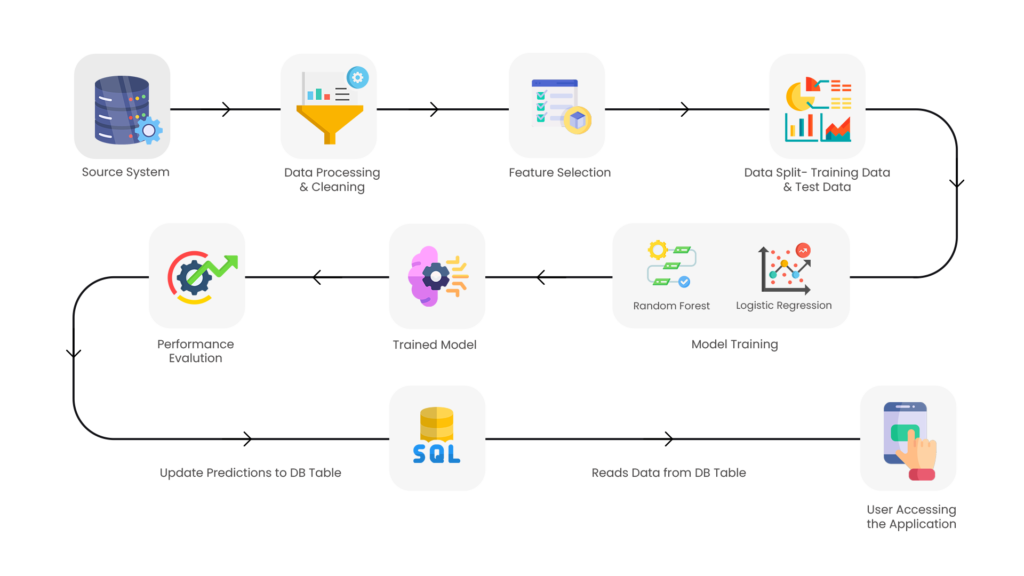Using AI/ML in Supply Chain
A Wallero customer had difficulty keeping track of their product shipments. Before the goods were transported in the consignment, the quality inspection team would inspect the batches manually. This effort by the field workers made it difficult to keep track of the consignment and consolidate the information. All these challenges delayed the process to determine the product delivery on time. Additionally, due to inaccuracies, a lot of products were wasted in the supply chain process.
To solve this problem, we intended to create an automated pipeline powered by Machine Learning capabilities that could help in processing the information more accurately, allowing field workers to make faster decisions. They were incurring an overhead cost of around 30% of their revenue owing to too many manual checks and processes.
Machine Learning for Business:
How AI and ML are Transforming Supply Chain Forecasting?
A typical machine learning model pipeline consists of several stages. These stages are sequentially executed to develop and deploy a machine learning model.
Here is the list of the common stages in an ML model pipeline:
Building a Training Pipeline
- Data processing (Exploratory Data Analysis)
- Data collection
- Data Preprocessing – data cleaning, fixing missing data, removing outliers, and formatting the data.
- Feature Engineering – Choosing relevant features for the ML model to learn and improve the model’s performance.
- Model Training – The dataset is split into training (for training the model) and validation sets (evaluating and tuning the hyperparameters).
- Model Evaluation / Registration – A suitable ML algorithm is selected that ranges from regression models (e.g., linear regression, random forest) to classification models (e.g., logistic regression, support vector machines). When a business’s needs are more complex and have a higher volume of data, then complex models like deep learning neural networks are used.
Building a Testing and Validation Pipeline
- Data Validation – Evaluated using the validation set or cross-validation techniques.
- Scoring – To assess the evaluation metrics such as accuracy, precision, recall, F1-score, or mean squared error (MSE).
- Results verification – Various combinations of hyperparameters are tested to find the optimal configuration to get the best model performance.
- Model Deployment and Output Results – Once the model training and evaluation are complete, the final deployment occurs to a production environment for predictions. The results can be integrated into an application for real-time use.
- Model Monitoring and Maintenance – It is important to monitor performance over time;retraining the model ensures its accuracy.

Implementing AI-driven Decision-making in the Supply Chain
Challenges Overcame:
Predictive Analytics for Optimizing Supply Chain Operations
- The key difficulty was to identify the data pattern and clean the data by removing unnecessary information. Identifying the most critical properties from an array of field information and building a suitable ML model from this complex information was a significant challenge.
- We studied the complete system workflow, comprehended the rationale that was underlying the manual decisions made by customers, and recognized the data trends. This activity also assisted us in fixing incorrect data and removing stale data from the system.
- We carefully examined the cleansed data for outliers in the distribution.
- The results were saved in a database table to determine whether they provide relevant forecasts and the accuracy of the predictions.
- To avoid the manual work of triggering the machine learning (ML) pipeline, we also defined the ML Ops solution using Azure ML, which initiated the ML pipeline on a regular basis.This ensuredthat every time a new set of data is added to the database for review, the model training, and the prediction accuracy is kept high.
Conclusion:
Leveraging AI and ML for Supply Chain Demand Prediction
When paired with Azure ML Ops, the Machine Learning model precisely managed business data and identifiedthe patterns to forecast future trends. By developing and executing good business strategies, the responsible team can take proactive measures to manage and minimize business loss.
While the ML model predicted solutions based on current data, ML Ops helped to act on the data on a regular basis to train fresh data and changing patterns for predictionenhancementand accuracy.This significantly reduced the time taken in training the ML model and efficiently handled the business use cases.












